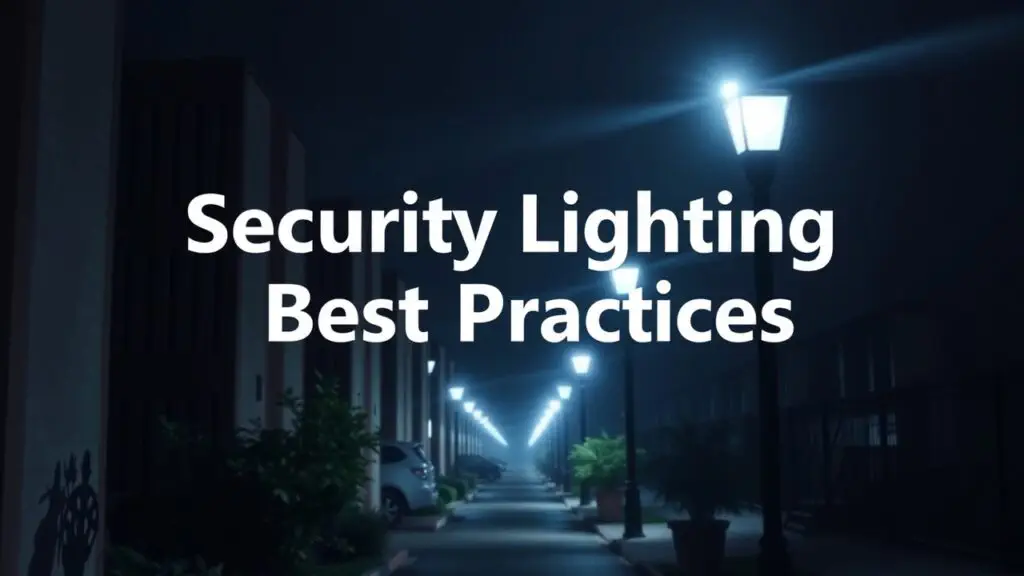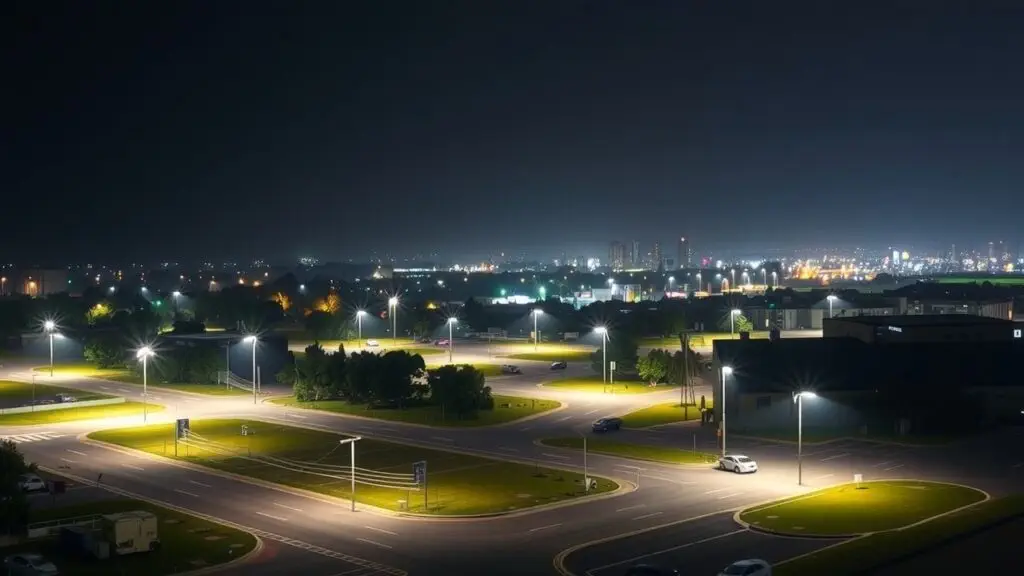Discover the different types of security lighting. Find the best security lighting for your home or business. This guide covers outdoor lighting, motion sensors, and smart options to ensure optimal protection.
The Importance of Security Lighting

Every year, millions of burglaries happen in the U.S. In 2020, over 1.1 million burglaries were reported (FBI). A great way to help stop these crimes is by using security lighting. When areas are well-lit, it makes it harder for criminals to hide, which helps improve safety for everyone.
Security lighting is made for outdoor use to boost safety and keep crime away. It serves two main purposes: it shines light on dark spots where bad guys might sneak around, and it helps people feel safer when they walk outside at night.
It’s super important to know about different types of security lights if you want the best protection. Each type has its own benefits that can help your home or business stay safe. For example, floodlights can light up a big area, while motion-sensor lights turn on when someone walks by. Picking the right lights can make a huge difference in how secure you feel.
Common types of security lighting to think about
- Floodlights: These are bright and cover large areas.
- Motion-Sensor Lights: These turn on when they detect movement.
- Solar-Powered Security Lights: These use sunlight to power up, so they’re good for the environment.
- Smart Security Lights: You can control these with your phone or smart home system.
By looking into these options more, you can find the right mix that fits your needs and makes your property safer.
Floodlights – Illuminating Large Areas
Floodlights are strong outdoor lights. They shine brightly over big spaces. You see them a lot in places like parking lots and sports fields. Their bright light helps keep areas safe and makes it easier to see at night.
Description of Floodlights: Broad Illumination and High Intensity
Floodlights give off a lot of light. They have wide beam angles, which means they cover large areas. The brightness can change based on the bulb used. This feature is great for places that need clear visibility at night or when it’s dark outside.
Bulb Types and Their Pros/Cons
When picking floodlights, you should know about the different types of bulbs:
- LED Security Lights: These are super energy-efficient and last a long time. They might cost more at first, but they save money over time.
- Metal Halide Security Lighting: These lights are cheaper to buy but use more energy and don’t last as long. They shine a bright white light but take longer to warm up.
- High-Pressure Sodium Lights: These bulbs give off a yellow light. They use less energy but can change the color of what they shine on.
Each type has its good and bad sides, depending on how much energy you want to use and how much you want to pay.
Use Cases for Floodlights
Floodlights work well in places that need lots of light. Some common uses include:
- Commercial Properties: Stores and offices use floodlights to stay safe after dark.
- Sports Fields: Good lighting lets games happen even when it’s late.
- Parking Lots: Bright lights help keep cars safe from thieves.
These examples show how useful floodlights are for keeping places secure.
Potential Drawbacks of Floodlights
Even though floodlights have many benefits, there are some downsides:
- Light Pollution: If floodlights aren’t installed right, they can cause too much light at night, bothering nearby homes.
- Energy Consumption: Older types like metal halide use more electricity than newer LED options. This can lead to higher bills.
- Installation Costs vs Long-Term Savings: Cheaper options might seem better at first, but they may break often, costing more later than a durable LED option.
Understanding both the good and bad sides of floodlighting helps people make smart choices about lighting for safety in their homes or businesses!
Motion Sensor Lights – Energy-Efficient and Targeted
How Motion Sensor Lights Work?
Motion sensor lights are cool gadgets that turn on when they sense movement. They work by using special sensors that can detect heat or motion. The most common type is the passive infrared (PIR) sensor. This sensor picks up body heat from people or animals. So, when someone gets close, the light switches on.
There’s also another type called microwave motion sensors. These sensors send out microwaves and check how they bounce back after hitting something. They can cover a bigger area and even see through walls. But they might react to smaller movements, too.
Energy Efficiency and Typical Applications
Energy-efficient security lighting can save you money on electricity bills while keeping your home safe. These lights often use LED technology, which uses less power than old-fashioned bulbs and lasts much longer.
Here are some common places to use these energy-saving lights:
- Pathways
- Driveways
- Entryways
- Patios
Using motion sensor lights in these spots makes it easier to see at night and keeps away potential intruders.
Various Designs Available
There are different designs of motion sensor lights you can choose from:
- Wall-mounted Lights: Great for front doors or garages.
- Pole-mounted Designs: Best for big areas like parking lots.
- Solar-powered Security Lights: Environmentally friendly options that charge up using sunlight during the day.
You can find these outdoor lighting fixtures at stores like Home Depot or online at Amazon.
Use Cases for Motion Sensor Lights
These lights don’t just help you see; they can scare off burglars, too! For example:
- Driveway Lighting: Helps you see when coming home at night.
- Entryway Lighting: Brightens your path as you walk up to your door.
When these lights suddenly shine, it surprises unwanted visitors and makes them think twice before coming closer.
Potential Drawbacks to Consider
While motion sensor lights are super helpful, there are some things to keep in mind:
- False Triggers: Sometimes pets or moving branches can set them off.
- Range Limitations: Some models may not see movement past a certain distance.
- Malfunctioning Issues: Like all electronic stuff, they can fail due to weather or wear and tear over time.
Knowing about these issues helps you pick the right products without any surprises later on.
Security Cameras with Integrated Lighting – Surveillance and Deterrence
Security cameras with integrated lighting are smart tools for home safety. They mix two important things: watching your property and lighting it up at night. This means you can see better when it’s dark, helping to keep an eye on your house and scaring off thieves. The night vision capabilities of these cameras let them capture clear pictures even when there isn’t much light. They use special night vision lighting that makes it easier to see without being too bright.
Examples of Integrated Systems and Their Features
A lot of new security systems combine cameras and lights for better use. Here are some cool features you might find:
- Remote viewing: Check your home from your phone anytime.
- Recording options: Save videos of everything that happens.
- Wireless security lighting: No messy wires needed for setup.
- Smart home integration: All devices can work together, so if the camera sees movement, the lights turn on automatically.
These features make it easy to monitor what’s going on around your home.
Advantages: Deterrence and Providing Evidence
Using security cameras with lights has great benefits. First, they help stop crime. When thieves see a well-lit area with cameras, they think twice before trying anything. Many studies show homes with visible security measures have fewer break-ins.
Also, if something does happen, these systems provide evidence. The video footage can help police find suspects or understand what occurred at your property.
Drawbacks: Cost and Data Privacy Concerns
Even though these systems are helpful, they have some downsides too. One is cost; good equipment can be pricey compared to standard setups.
Another concern is data privacy. With more devices connected to the internet, there’s a risk of hackers getting into your camera feeds or personal information if you don’t secure them properly. Homeowners should think about this before getting installed systems.
In the end, choosing security cameras with integrated lighting can boost safety while giving you peace of mind about your home.
Low-Level Lighting (Ambient Lighting) – Enhancing Overall Visibility
The Role of Ambient Lighting in Creating a Safer Environment
Low-level lighting, or ambient lighting, is super important for safety and visibility. When we light up walkways, gardens, and outside areas, it helps people see where they are going. This makes it safer and helps prevent falls.
Brightly lit areas also make people feel safer. If a place is well-lit, it can stop bad guys from trying to do something sneaky. They don’t want to get caught in the light! So, using low-level security lighting is a smart choice for homes and businesses.
Examples of Low-Level Lighting Solutions
There are different types of low-level or ambient lights that can make your outdoor spaces both pretty and safe:
- Pathway Lights: These lights guide visitors along walkways so they don’t trip.
- Bollard Lights: These short post lights shine on paths without being blinding.
- Landscape Lights: These lights show off your garden features like trees or sculptures while adding some general light.
You can find many styles online at stores like Home Depot or Amazon to suit your needs.
Use Cases for Low-Level Lighting
Low-level lighting works best in certain places:
- Residential Areas: Putting pathway lights along sidewalks helps guests find their way safely at night.
- Walkways: Bollard lights light up dark paths in parks or big yards.
- Gardens: Landscape lights not only make gardens look nice but also keep people from tripping over things after dark.
These ideas show how useful low-level lighting can be when placed smartly outdoors.
Potential Drawbacks of Low-Level Lighting
Even though low-level lighting has great benefits, there are some downsides to think about:
- It might not be strong enough alone to keep bad guys away compared to brighter security measures like floodlights.
- If too many lights are used, they can cause light pollution which isn’t good for nature.
By knowing these points, homeowners can plan how to use lighting in their security plans while still keeping things nice-looking and functional.
Choosing the Right Security Lighting – Key Factors and Decision Guide

Factors to Consider
When you want to pick the right security lighting, think about a few important things.
- Budget: The price of security lighting can change a lot. LED lights might cost more at first, but they save money on energy later. When planning your budget, look at both how much you spend to install and what you’ll pay for power later.
- Area to be Lit: The size and shape of the place you want to light up matter. If you have a big yard, floodlights can cover a lot of space. For smaller areas like paths, low-level lights are better. They help you see without being too bright.
- Security Needs: Different places need different types of lights. For high-security spots, strong floodlights are good to keep bad guys away. For homes, softer lights can keep things safe without being too harsh.
- Environmental Considerations: Light pollution is a problem in many places. Choosing lights that direct light down can help this issue. You might also want eco-friendly options like solar lights since they are better for the Earth.
Step-by-Step Guide
- Assess Your Budget
Think about how much money you can spend on setting up and keeping different types of security lights running, like LED floodlights or solar-powered options. - Determine the Area to be Lit
Figure out which spots need light—like entryways or driveways—and choose the right lights for each area. Pathway lights work great for walking paths, while brighter options fit large spaces better. - Define Your Security Needs
Decide if you need bright floodlights for serious protection or softer lights that just keep your home safe at night. - Factor in Environmental Considerations
Pick products that help cut down on light pollution and follow local rules about outdoor lighting. This way, you’ll respect community standards and protect the environment. - Select Appropriate Light Types
Look into various bulbs today—like energy-saving LED motion sensor lights that turn on when someone is near or traditional halogen lights if you need them for specific purposes. - Consult Professional Help if Needed
If you’re not sure how to set things up or what will work best for your space, talking to an expert in outdoor lighting can really help.
By keeping these points in mind while choosing your security lighting, you’ll make sure your space stays safe and looks good too!
Best Practices for Effective Security Lighting Placement and Maintenance
Placement
When you think about security light placement, it’s really all about keeping your space bright and safe. Start by looking at your property. Find key spots like doors, driveways, and any dark corners where you can’t see well. For outdoor lighting installation, focus on these areas to boost illumination levels.
Using different types of lights helps too! Floodlights spread light over wide areas. They work great for places like driveways or backyards. Spotlights are perfect for shining directly on doors or windows. This way, you can highlight spots where someone might try to break in.
To keep your perimeter secure, place lights at different heights and angles. This layered approach makes sure there are fewer shadows for intruders to hide in while improving light coverage.
Layered Approach
A layered approach to security lighting means using different kinds of lights around your home or business. For homes, mix motion sensor lights with steady lights near paths and doors. Motion sensor lights turn on when they see movement, which saves energy since they only light up when needed.
In businesses, use bright LED lights in busy spots but stick to softer lights in less crowded areas. This mix keeps important areas well-lit while saving energy in the whole system.
By adding layers of light sources like path lights with wall-mounted sconces, you create a safer space that discourages unwanted guests with consistent brightness everywhere.
Regular Maintenance
Regular maintenance is key for your security lighting system to work well all year round. Start by checking all bulbs regularly. If one burns out, replace it quickly so your space stays lit all the time.
Energy-efficient lighting like LEDs lasts longer than regular bulbs, but they still need checks for issues. Also, remember to clean motion sensors often because dirt can make them not work properly.
Setting up a maintenance schedule helps you keep track of bulb replacements and overall upkeep of your outdoor lighting systems. This way, they remain reliable protectors against possible threats.
Integration with Other Systems
Connecting your security lighting with alarm systems and cameras boosts safety a lot! When these systems work together within smart home setups, they can trigger lights automatically if alarms go off or cameras spot movement at night.
For example, if an alarm sees an intruder through the camera during nighttime hours, the connected alarm can turn on nearby outdoor lights right away. This instant lighting can scare off anyone trying to enter before they even reach the door!
Having this teamwork between different technologies not only improves safety but also gives peace of mind to homeowners knowing their properties are watched closely day and night.
FAQs
What are the common materials used for security lights?
Security lights can be made from aluminum, stainless steel, or plastic. Each material has its own benefits in durability and aesthetics.
What are the key features of bollard lighting?
Bollard lighting offers low-level illumination along pathways. It helps to enhance safety while also adding aesthetic appeal to outdoor spaces.
What is perimeter lighting and why is it important?
Perimeter lighting surrounds a property to deter intruders. It provides visibility and creates a secure boundary around homes or businesses.
How do I choose between different bulb types for my security lights?
Consider energy efficiency, brightness levels, and lifespan when choosing bulbs. LED bulbs are popular for their longevity and low power consumption.
What is dark sky compliant lighting?
Dark sky compliant lighting reduces light pollution. It directs light downwards, protecting the night sky while still providing safety.
What should I know about security lighting regulations?
Local regulations may require specific light types or placements. Always check local codes to ensure compliance and safety.
Security Lighting Standards
- Understand the importance of IES (Illuminating Engineering Society) standards.
- Check the required lux levels for your area.
- Use photometrics to measure light distribution effectively.
Energy Codes for Security Lighting
- Be aware of energy-saving codes in your region.
- Choose energy-efficient models like LED or low-pressure sodium lights.
- Factor in wattage and power consumption when selecting fixtures.
Lighting Design Considerations
- Utilize outdoor lighting design software for planning.
- Assess beam angles and light coverage requirements.
- Implement proper spacing for effective illumination levels.
Security Light Lifespan and Maintenance
- Regularly check the lifespan of various bulbs.
- Plan a maintenance schedule for timely replacements.
- Ensure all fixtures remain clean and functional to maximize effectiveness.
Related Topics
- Types of security lights
- Types of security light bulbs
- Types of motion sensor lights
- Types of outdoor lighting fixtures
- Types of low-level lighting
- Types of ambient lighting
- Types of security lighting placement
- Types of security lighting maintenance
- Types of smart home security lighting integration
- Types of materials for security lights



Types of Security Lighting: A Complete Guide